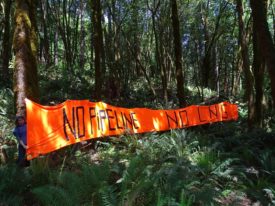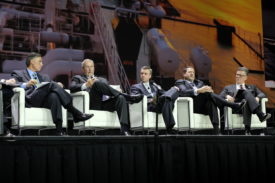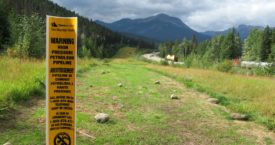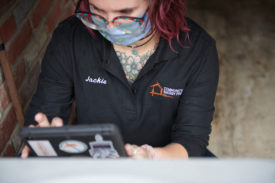Anna:
This is from the Ringside Seat email I get from the American Prospect. The climate impact analogies are vivid and alarming: “Mother Jones follows climate-change dynamo Jason Box to Greenland’s ice sheet to learn that it’s halfway to snowcone and might go full slushie way ahead of schedule.”
Meanwhile, researchers are looking to fossil formations for clues from past climate changes to help predict sea level rise due to man-made global warming.
The real story about solar energy isn’t necessarily being told by the mainstream media. Media Matters debunks common myths, one by one, concluding that we’re in the midst of a solar energy boom.
Are you one of Seattle’s thrift store fashionistas? The Seattle Times and local fashion blogger Dana Landon just launched a contest for the best secondhand styles.
Alan:
I spent Sunday marveling at the miracles of nature in the Nisqually National Wildlife Refuge. So I was chastened to read Thomas Lovejoy’s NYT op-ed and be reminded me that that place—and its creatures—are “dead men walking.” Climate change will likely raise sea level enough to flood virtually the entire refuge. Lovejoy, whom I had the honor to meet some years ago, is right on the money in this piece. What worries me most is that while there is a global movement to slow climate change, efforts worldwide to save the diversity of life on Earth do not add up to a movement yet.
A humorous and playful but ultimately deadly true commentary about the North American way of death: the way we segregate the aging and the ill from a youth- and health-idolizing culture.
On the same theme is another NY Times piece, also well worth your time. The way the US medical care system responds to life-threatening health conditions is better than it used to be, but it remains troubling. As this article explains, most doctors would never get the kind of end-of-life medical care many of their patients get:
Almost all medical professionals have seen what we call “futile care” being performed on people. That’s when doctors bring the cutting edge of technology to bear on a grievously ill person near the end of life. The patient will get cut open, perforated with tubes, hooked up to machines, and assaulted with drugs. All of this occurs in the Intensive Care Unit at a cost of tens of thousands of dollars a day. What it buys is misery we would not inflict on a terrorist. I cannot count the number of times fellow physicians have told me, in words that vary only slightly, “Promise me if you find me like this that you’ll kill me.”
Eric:
To me, the most arresting article this week was SNL Financial’s interview with former Montana Governor Brian Schweitzer, a long-time booster for coal. When asked about the proposed export terminals in the Northwest, he had this to say:
You call those plans? I don’t see the plan that’s getting built. A plan is when you put it on a piece of paper and pay somebody to start pouring concrete. I’ve been out there looking at these things. I think Cherry Point is dead.
The Millennium project in Cowlitz County there that Ambre has proposed, that is far out into the distance. Ambre has also got a plan that they hope to get built along the Columbia River on the Oregon side. But I think that Oregon has poked a big hole in that balloon. So the only export terminal that we really have is in Vancouver, and now they’ve got their locals up in arms when Westshore has proposed to increase from about 27 [million] to about 30 million tons.
Ten years from now, maybe there will be some export capacity on the West Coast, but for right now, what we have is completely full and what has been proposed is probably dead — and not even dead in the water, just dead.
Schweitzer is very knowledgeable about the coal industry and now he’s got everyone wondering if he knows something we don’t.
Apparently, the Washington transportation department wants to remove the old 520 “ramps to nowhere” that grace Seattle’s arboretum like the ruins of some ancient freeway-building civilization. This, in my opinion, is a terrible idea. The old ramps make for an accidental playground in the city, perfect for leaping off into the lake on a hot summer’s day as I did when I was a kid. More importantly, they are a monument to the past, and a physical reminder that bad ideas can be stopped. (In this case, the planned R.H. Thomson Expressway that would have destroyed a huge swatch of the Central District and Madison Valley neighborhoods.) I’m looking forward to seeing what Knute Berger has to say on the matter.
A reader from the small mountain town of Packwood, Washington points me to these fascinating “rail” maps for California. They’re subway system-like productions that illuminate the huge number of places that you can reach by transit in the Golden State. As he points out, “a Cascadia map could showcase long-distance rural bus routes that can expand the scope of the rail and urban transit system… by taking Grays Harbor and Pacific Transit buses, the north Oregon coast and Long Beach Peninsula are accessible via the Olympia Transit Center to all the Puget Sound area transit systems.” We should have something like this for Cascadia, no?
Speaking of buses, if you’re a Seattle bus rider—and particularly if you’ve ridden the 358—you may enjoy The View from Nathan’s Bus. It’s an astonishingly well-written blog on the tribulations and exultations of being a city bus driver.
Oregon Public Broadcasting has a great video about Portland sculptor Bonnie Meltzer who has been using her art to protest the coal export plans.
What does Michael Bluth have in common with Ivan Karamazov? More than you might think.









jonesey
Re: the California Rail Maps, someone has begun raw data collection for the PNW version of this, here:
http://www.epictransitjourneys.com/index.php?title=Main_Page
Now we need a great graphic designer to glue it together.